Unit 4 Where is the schoolbag?
Section A 1a-2e Period2
Teaching and learning Goals:
一.语言功能:
1.能够就物品的位置进行问答,做简单的对话。(Identify colors)
Where’s the 名词单数…? It’s in/on/under….?
Where are the 名词复数…?They’re in/on/under…?
2.能够正确读出下列单词:
where table bed bookcase sofa chair on under
3.初步尝试在听力中抓关键信息。
二.常用词汇短语和表达:
1.争取能够掌握以下词汇(听说读写):
where table bed bookcase sofa chair on under
2.学会运用介词 in on under
3.争取能够正确Where引导的特殊疑问句询问物品位置(where questions)
三.学习策略:
1.利用物品所放的位置学习介词的用法。2练习在听力过程中寻找关键信息。
四.情感态度:
整理好自己的房间,保持房间整洁,物品不要乱扔乱放
Teaching and learning steps:
Step I. Pre-listening activities
1. Preview
Ask the Ss to translate the following Chinese into English or English into Chinese orally, then let them match the words and the pictures and write English down without looking at the textbooks.
1. table______ A
2. bed_______ B 
3. bookcase____ C 


4. sofa____ D
5. chair______ E
6. schoolbag___
7. books_____ F
8. keys_____ G 
H 


2. 把下列短语和句子翻译成汉语(P19-20)
1.在铅笔盒里 ____________ 2.在书上 _______________
3.在椅子下面 _____________ 4.在沙发上_______________
5.在他们床上 _____________ 6.在你爷爷奶奶的房间里______________
7.我的书包在哪里?________________________________________________
8.它在桌子底下 ________________________________________________
9.钥匙在哪里? ________________________________________________
10.他们在书包里 _______________________________________________
11.书在课桌上吗? _______________________________________________
12.是的,它们在 _______________________________________________
(设计说明:本部分词组和句子单词为学生的预习作业,词组和句子都是本节课的重要语言知识,该部分预习内容可以帮助学生更有目的性的预习。同时通过检测学生的预习效果,教师可以更有针对性地教,学生可以更有针对性的学。)
3. Lead in
 (1)Show some pictures of things. Ask:
(1)Show some pictures of things. Ask:
 T;What’s this?
T;What’s this?
S:It’s…
T: Where’s the clock?
S : It’s on the chair.
T : Where are the books? 
S : They are in the bookcase。… .
(2) Have the Ss try making the similar dialogues with other things in groups of two. Show some pictures to them





(设计说明:先给学生们创设易于理解和表达的语境,学生对单复数也一目了然。并逐步引导学生们在实际运用中练习所学,从而引入要学的新内容物品位置的辨别和表达,以及怎样新旧结合。)
Step II. While-listening activities
1. Listen and find the general idea.
The conversation is mainly about ________.
A. the color of the things B. the number of the things C. the position (位置) of the things
2.Listen and number the things in the pictures(1-4),Finish 1b
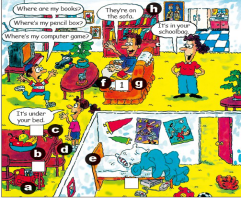
3. Listen and find the general idea. Finish2a


4. Listen again. Find the things from 2a and number them in the picture [1-6].Finish 2b
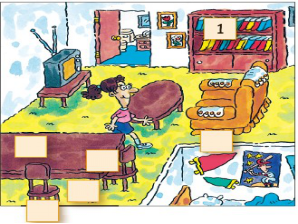
5.Listen and find the specific ideas.
Listen again and fill in the blanks.
Tom: Hey, Helen.
Helen: Yes?
Tom: Is my computer game __________ ?
Helen: No, it isn’t. It’s ____________
Tom: Oh, OK. How about my books? Are they_________, too?
Helen: No, they aren’t. They’re __________
Tom: Oh. So, where ‘s my schoolbag?
Helen: It’s___________. And your ruler is under the chair.
Tom: Oh, I see. And where are Mom’s keys
Helen: The keys? They’re ___________
6. Listen to the conversation more carefully and read after the tape.
Read after the tape then ask and answer in pairs .
Choose some groups of them to talk about the colors in front of the class.
( 设计意图:通过本项训练,旨在培养学生获取重要信息的能力,并能通过上下文来猜测,核对信息。本环节所设计的空格正好用来检测前面所学过的单词和本单元生词课所学的表示方位词汇。通过授课,介词很容易听出来。建议在听之前给予提醒,本段听力所涉及的方位介词是重点。)
Step III. Post-listening activities
1. Ask and answer in pairs using the following pictures

Are the keys in / on / under the …?
Yes, they are./ No, they aren’t.
2. Play a guessing game.
Teacher will show pictures one by one, first cover part of the picture. Let students guess
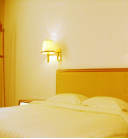
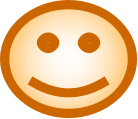




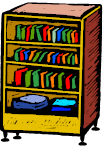

A: Where’s the chair? B: It’s under the table.
A: Where’s the backpack? B: It’s on the bed.
A: Where are the books? B: They are ...
A: Where are the keys? B: ...They’re on the sofa.
(设计说明:通过游戏的形式让学生感兴趣,愿意参与,同时为学生们创设较为真实的语用环境,使学生们体会所学的语言是真实可用的,本部分的内容重在培养学生们口头表达的能力,同时通过复述做对话引导学生更好地内化语言知识。)
Step IV Role-play the conversation
Role-play the conversation. Show a picture of a room. Give the Ss one minute to look at it,one is Jack one is Mom. and then ask them to act it out.
Mom:Come on,Jack!
Jack:Oh,no!Where’s my bag?
Mom: Hmm…is it on your desk ?
Jack: No. And it’s not under the chair .
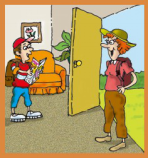 Mom: Oh! It’s on the sofa.
Mom: Oh! It’s on the sofa.
Jack: Thank you, Mom. Err…Where is the map ?
Mom: I think it’s in your grandparents’ room.
Jack: Yes, it’s on their bed! And my hat?
Mom: It’s on your head.
Jack: Oh, yeah! Haha!
Step V. Summary:Inquiry into knowledge by translation
1. where’s the map?
_______________________________________
“Where is/are …?” 这一句型表示“______” ._________是 Where is 的缩略形式。其后是“定冠词/物主代词+名词”的结构,此时的名词为可数名词单数或不可数名词。回答时为了避免重复,用 ____________ 来做为答句的主语,然后再加is和介词短语。Where’s的复数句型是______________ 。Where are 后的名词为________,回答时用they 作主语。
1)-----我的书在哪里?------在那儿。
---Where is my book?------ __________ there.
2)------他的钥匙在哪儿?---在书桌上
------Where are his keys?---_________ on the desk.
2.It is under/on/in the desk.
____________________________________
这是用来表示方位的句型,意为“某物在某个地方”。句中的介词和短语都是用来表方位的。该句型的结构为“主语+_______+ 表示方位的介词+表示地方的名词”。 Under 意为 ________ ; on 意为_______;in 意为________
如:在床上 _________ 在桌子上 ______ 在书包里 _______
(设计说明:教师要引导学生们运用他们从实践中的感知来尝试归纳语言规律,然后再给以必要帮助。通过小组讨论的形式可获得更为准确的答案,老师只给适当点拨。)
Step VI. Exercises: the end-of- class test
Ⅰ.词汇
1.My ____________ (钥匙)are on the table.
2.—____________(在哪里)is the baseball?
—I don't know.
3.My backpack is ____________(在……下面)the dresser.
4.Please ____________(带来)your dictionary to school tomorrow.
5.The boy is ____________(在两者之间)Betty and Kate.
II.句型转换
1.The books are in the bookcase.(改否定句)
______________________________________
2.The baseball is under the bed.(改一般疑问句)
_______________________________________
3.The pictures are on the wall.(对划线部分提问)
_______________________________________
4.Is the CD on the sofa?(做肯定回答)
_______________________________________
5.Are the chairs next to the table?(做否定回答)
_______________________________________
6.on,T-shirt,the,his,is,bed(连词成句)
________________________________________
III.完成句子
1.他的书包在桌子下面。
His ____________ is ____________ the table.
2.我的字典在沙发上。
____________ dictionary is ____________ the sofa.
3.我的棒球在哪里?
____________ my baseball?
4.我的钥匙在梳妆台上吗?没有。
____________ my ____________ on the dresser?
No,____________ ____________.
5.台灯在床边上吗?是的,在床边。
Is the light ____________ ____________ the bed?
Yes,____________ ____________.
Step VII. Homework
1. Read 2d after the tape and recite them.( ★ )
2. Make your own conversations using your own things. ( ★★ )
3. Preview next period.( ★ )
本节课亮点:
1. 预习部分的词组和句子都是本节课的重要语言知识,该部分预习内容可以帮助学生更有目的性的预习。同时通过检测学生的预习效果,教师可以更有针对性地教,学生可以更有针对性的学。
2.导入部分,展示一些彩色图片从视觉上吸引学生,让学生更容易感兴趣,也更容易在语境中去理解句型。先给学生们创设易于理解的语用情景,并逐步引导学生们在实际运用中初步感知如何依据事实做推测。
3. 其中的猜测游戏为学生们创设了较为真实的语用环境,使学生们体会到所学的语言是真实可用的。
4. 家庭作业分层布置,让学习能力强的同学做更能体现他们高水平的作业。
使用注意事项:
1.听后活动是听力的输出部分,教师可以根据时间再具体调控量的多少。翻译探究部分要先让学生自己动脑思考,不会可与小组成员讨论解决,教师只可起点拨作用。
2.预习内容一定要提前布置给学生,便于学生更有目的性的去预习,提高课上做题速度。
Keys:
1. Preview
一.1-B2-E3-G4-F5-A6-D7-C8-H
二.1.in the pencilbox 2.on the book
3. under the chair 4.on the sofa
5.on their bed 6.in your granparents’ room
7.Where’s my school bag ? 8.It’s under the table
9.Where’ re the keys? 10.They’re in the schoolbag
11.Are the books on the desk? 12.Yes,they are
Step II. While-listening activities
1. Listen and find the general idea.(B)
2.Listen and number the things in the pictures(1-4)
1.books 2.pencil box 3.computer game 4.keys
3. Listen and find the general idea. Finish2a
2.books 6.keys 1.computer game 5.ruler 3. pencil box 4.schoolbag
4.Listen again. Find the things from 2a and number them in the picture [1-6].Finish 2b
Answers: 1.computer game in the bookcase 2.books on the chair
3.pencil box under the sofa 4.schoolbag under the table
5.ruler under the chair 6.keys on the table
5.Listen and find the specific ideas.
Listen again and fill in the blanks.
on the table in the bookcase. in the bookcase on the chair. under the table on the table.
Step V. Summary:Inquiry into knowledge by translation
1.地图在哪里? 事物在哪里? Where’s It Where’re 可数名词复数
1)It’s 2) They’re
2它在书桌下书桌上书桌里 be 在…..下 在….. 上 在 ……里
如:on the bed on the table in the schoolbag
Step VI. Exercises: the end-of- class test
Ⅰ.1.keys 2.Where 3.under 4.bring 5.between
Ⅳ.1.The books aren't in the bookcase.
2.Is the baseball under the bed?
3.Where are the pictures?
4.Yes,it is.
5.No,they aren't.
6.His T-shirt is on the bed.
Ⅵ.1.backpack,under 2.My,on 3.Where's 4.Are,keys,they,aren't 5.next,to,it,is

